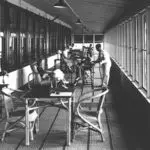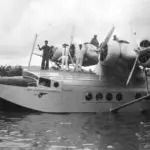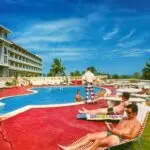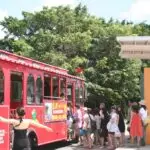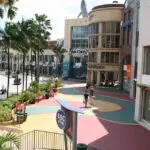Evolution of the Tourism Industry on Guam
Table of Contents
Share This
Interpretive essay: Multi-step process
To understand the evolution of tourism in Guam, it is useful to reflect on events that have happened since the advent of tourism in the early 1970s.
A typical tourism system consists of four distinct stages. First there is the creation of a demand. People such as Juan Tripe, a Pan American Airlines visionary; David Tuncap, former operations manager for Pan American Airlines; Herbert Fukuda and Earl Kloppenburg of Turtle Tours; Robert and Margaret Jones, Guam tourism proponents; Rex Willis of the Guam Tourism Commission; and Bert Unpingco, Guam’s “Mr. Tourism” are some of the pioneers who helped cultivate this demand. This demand was created after an initial 109 passengers aboard Pan Am Flight 801 departing from Haneda, Japan traveled to a newly discovered, exotic, tropical destination called Guam in 1967.
Ironically, Guam was occupied by Japan during World War II and were considered enemies during that time. Just 20 years later the Japanese were welcomed as visitors to the island.
The second stage of establishing a tourism industry is developing a means of transporting people to their desired destination. For the next 40 years a tremendous succession of international airlines such as Pan American, Continental Micronesia, Japan Airlines, Northwest, Braniff, American, Trans World Airways, South Pacific Island Airways, Hawaiian Air, United and others who sought to capitalize on the interests of those who wished to travel to Guam, eventually growing to 1.4 million people annually. The island today serves as an air transportation hub for passage to and from Asia, Micronesia and the Western world.
The third stage consists of providing a supply of attractions, lodging and accommodations for the traveler. From the humble beginnings of a Pan American Hotel built in Sumai in the 1930s and the Cliff Hotel in Agana Heights established in 1959, by the year 2009 more than 28 hotel properties were in operation such as the Hilton Resort & Spa, Sheraton Laguna Guam, Pacific Islands Club, Guam Marriott Resort, Fiesta Resort, Guam Reef Hotel, Outrigger Resort, Guam Hotel Okura, and Nikko Resort Hotel Guam.
Guam has also increased its attractions from a basic sightseeing, war relic, and omiyage (souvenir or gift) destination to one that offers world class shopping and entertainment. In addition to eco-tourism attractions such as marine sports and outdoor adventures, there have been an increasing number of shopping and leisure activities that have developed in response to visitor demand. The island’s hospitality industry has also gradually moved from an eight-hour daytime operation to a round the clock operation.
The fourth and final stage of this tourism system is the communications, signage and marketing designed for visitor satisfaction. There has been been a tremendous surge in recent years of promotions and advertising of the Guam experience and Guam companies on a worldwide basis. Visitor signage has also been greatly enhanced throughout the island and has encouraged more freedom in traveling throughout the island’s villages than in the past.
It is this overall system that contributed to the development of Guam as a favorable resort destination and produced a rate of 25 of every 100 visitors returning for multiple visits.
Tourism today
A tourist is generally described as someone who has traveled more than 50 miles from home and has spent the night in another location. The Guam Visitors Bureau reported a total of 1.4 million arrivals in 2009, an increase of 0.6 percent from 2005 and a growth rate of 6.17 percent. About 81 percent of visitor arrivals are from Japan with the remaining visitors coming from Korea, Taiwan, Hong Kong and other Asian countries. A typical visitor to Guam spends approximately $1,650 for a three night, four-day stay on the island. Of this total expense, $1,100 is for a package tour and the estimated balance of $500 is spent on entertainment, meals and other activities.
Guam’s lodging and accommodations consists of 7,250 hotel rooms as of April 2007. The Guam Hotel and Restaurant Association reported 4,785 employees working in 26 hotels during April 2007. A March 2007 Current Employment Report issued by The Guam Department of Labor showed 5,440 workers employed in hotels and other lodging places and a total of 10,480 persons employed in the island’s service industries.
Average hourly wages reported by the Guam Department of Labor for hotel employees was $6.86 for a 36-hour work week. Global Insight, Inc. in its Tourism Satellite Account Study reported an average salary of $19,468 ($9.36/hr) for those in tourism employment.
Tourism role
The Guam Economic Development and Commerce Authority presented details in 2006 which showed that military contributions to Guam’s economy in the early 1960s amounted to sixty-five percent of the total economy, while tourism contributed thirty percent of the total and the remaining five percent was attributed to other sources. This was at a time when there was a very strong armed forces presence on the island.
However, GEDCA reported that during the 1970s contributions from the Armed Forces to Guam’s economy had declined to approximately 20 percent. This decline was attributed to President Regan’s executive order A1C that converted federal activities to privatized ventures. The US Naval Station Guam was dramatically affected by the loss of an estimated 6,000 civil service skilled trade jobs that were transferred to other parts of the nation. This change also signaled the growth of a private economy fueled by tourism, in terms of both visitor arrivals and high levels of spending.
The year 2007 showed yet another reversal in the geopolitical environment with the announcement of an impending withdrawal of military bases in foreign countries and a re-alignment of some defense resources in Japan to Guam. The US Marines are working to re-locate 5,000 soldiers to Guam with an estimated 14,000 dependents from Okinawa, Japan. This increase in military presence has caused serious concern regarding the ability of the social and physical infrastructure to sustain a population of this size without significantly overtaxing its resources. As of 2021 the new Marine Base, named after General Vicente “Ben” Blaz, was underway.
Consequences and conclusions
Perhaps the findings of Global Insight, Inc. demonstrated the most logical analysis and projections of the influence of tourism on Guam in June 2007. This company was contracted to measure the impact and outcomes of tourism on Guam’s economy by equating it with industry measurements elsewhere, allowing for useful comparisons.
Some of Global Insight’s findings on the impact of visitors to Guam were:
- One job on Guam is created for every $76,000 in additional visitor spending
- For every $1 spent by Guam Visitor’s Bureau in its budget, there is a return of $82 in visitor spending
- Guam Visitor’s Bureau returns $10 in taxes for every $1 in their budget
- If tourism didn’t exist, each household would pay an additional $2,710 in taxes to maintain the current level of tax receipts
- Travel and tourism spending in 2005 on Guam was found to be: Shopping (42.9 percent), Lodging (30.8 percent), Entertainment (14 percent), Food and Beverage (11.5 percent), and Transportation (0.8 percent) or a total dollar spending level of $1,167 per visitor
- A total of 10,419 direct full-time equivalent jobs were found in core tourism in 2005 making it the third largest private sector employer on island, contributing 24.3 percent of non-government island employment and $202.8 million in wages and salaries that same year.
For further reading
Fawcett-Flores, Ginger. “40 Years of Tourism.” GU Magazine (May/June 2007).
Guam Department of Labor. Current Employment Report. By Gary A. Hiles. #2007-05. Tamuning: GDOL, 2007.
Guam Economic Development Authority. Economic Strategy Plan. Tamuning: GEDA, 2005.
Guam Hotel & Restaurant Association. Monthly Hotel Statistical Report. Tumon, GHRA, 2007.
Guam Visitors Bureau. “Guam Tourism | Guam Hotels, Restaurants, Events, and Things to Do.”
MicronesiaTour.com. “Micronesia’s Official Travel and Tour Website.”
Mill, Robert C., and Alexander M. Morrison. The Tourism System: An Introductory Text. Englewood Cliffs: Prentice Hall, 1992.
White, Sondra. “The Evolution of Tourism on Guam.” Guam Business 18, no. 9 (November 2000): 2-27.

